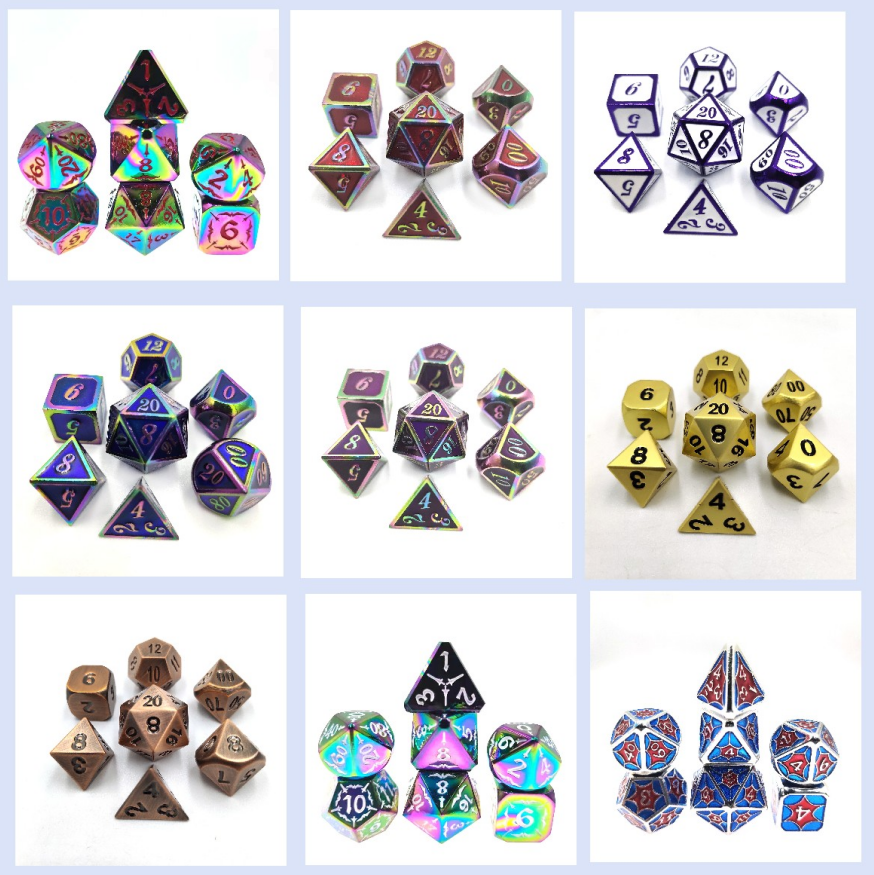Dice, those small polyhedral objects, are not mere components in tabletop gaming; they are iconic symbols of chance, strategy, and excitement that have been integral to gaming throughout history. The rich
tapestry of their impact on the gaming experience unfolds through various facets, each contributing to the depth and universality of tabletop gaming.

At its core, the roll of the dice introduces an element of unpredictability, embodying the essence of chance in gaming. Whether in classic board games, strategic tabletop games, or the intricate realms of
role-playing games (RPGs), the roll of the dice injects excitement and uncertainty into every play. The anticipation of a favorable outcome or the tension of facing an unfavorable roll creates moments of
suspense that captivate players.
Dice come in a fascinating array of shapes, with the six-sided cube being the most common. However, the gaming landscape is enriched by polyhedral varieties, each with a unique number of sides—
four-sided, eight-sided, ten-sided, twelve-sided, and twenty-sided dice. This diversity offers game designers a palette of possibilities, influencing the mechanics, probabilities, and dynamics of the games
they create.

The strategic aspect of dice is a nuanced dance between chance and decision-making. Players must navigate the probabilities associated with different dice rolls and adapt their strategies accordingly. The
blend of chance and strategy is a defining characteristic of tabletop games, challenging players to make informed decisions while embracing the unpredictability that dice bring to the table.
In the realm of RPGs, dice play a central and narrative-shaping role. Dungeons & Dragons, a seminal RPG, utilizes an array of polyhedral dice to resolve combat, skill checks, and other in-game events. The
randomness introduced by these dice not only determines success or failure but also adds unexpected twists to the unfolding story. This narrative element enhances the immersive storytelling experience,
making each session a unique adventure.
Beyond their role in gameplay mechanics, dice have become a canvas for artistic expression and personalization. Crafted from materials such as plastic, metal, or even gemstones, dice sets showcase
intricate designs, colors, and engravings. The world of customized dice has emerged, where players seek sets that resonate with their personal preferences, transforming these humble gaming tools into
coveted collectibles.

The educational value of dice extends beyond gameplay, offering a practical and engaging way for players to grasp concepts of probability and basic mathematics. As players calculate odds, assess risks, and
strategize based on the probabilities associated with different dice outcomes, they develop analytical skills in a context that feels more like play than study.
The digital realm has embraced the concept of dice through random number generators (RNGs) that simulate the unpredictability of physical dice rolls. Whether in computer games, mobile apps, or online
platforms, the essence of dice mechanics persists, preserving the blend of chance and randomness in a virtual setting.
Dice, however, are not merely tools for gameplay; they carry cultural symbolism and even superstitions within the gaming community. Some players have rituals or lucky dice they believe influence outcomes,
adding a touch of ritualistic magic to the act of rolling dice. The classic six-sided die, known as the "standard d6," has transcended its utilitarian role and become an iconic symbol associated with gaming itself.
The social dynamics that dice introduce to the gaming table are profound. The act of rolling dice becomes a communal experience, fostering shared anticipation and excitement among players. Whether
celebrating a critical success or commiserating over an unexpected failure, the shared moments around the dice rolling table create bonds and memories that endure beyond the game itself.
Dice's simplicity and universality make them accessible to players of all ages and backgrounds. Their use in classic board games, strategic tabletop games, and RPGs transcends cultural and linguistic barriers,
making them a unifying element in the diverse world of tabletop gaming. The tactile experience of rolling dice, the clatter as they hit the table, and the shared laughter or groans that follow create a
universal language that brings players together.
In conclusion, dice are not just tools for generating random numbers; they are storytellers, artists' canvases, symbols of chance, and catalysts for social interaction. Their impact on tabletop gaming is
immeasurable, weaving a narrative that extends from the earliest board games to the most sophisticated RPGs. As the world of tabletop gaming continues to evolve, the timeless allure of dice ensures their
enduring place at the heart of the gaming experience.